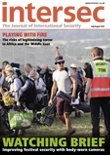Built-in security
Chris Driver-Williams examines how security and blast-mitigation can be designed into otherwise vulnerable buildings to limit the effects of terrorist attacks
As he neared the end of the bustling rush-hour journey through Downtown Oklohoma City, the former soldier-turned security guard reached down into the foot-well and calmly lit the end of the burning-fuse. He glanced at his watch. It was 8:59am. Timothy McVeigh then parked the rented Ryder truck in front of the Alfred P Murrah Federal Building and drove off in a waiting getaway car. Three minutes later, at precisely 9:02am on 19 April 1995, McVeigh’s truck bomb – packed with a potent cocktail of agricultural fertiliser, diesel, and other chemicals, exploded into a deadly fireball of supersonic fragments. As the powerful blast ripped through the multi storey building, hundreds of tonnes of glass and concrete rained down onto the street below as hundreds of innocent victims lay dying and bleeding. A third of the building was instantly reduced to rubble. Scores of cars were incinerated and more than 300 nearby buildings were damaged or destroyed.
Sadly, such attacks have become a familiar feature of modern life around the world. On 26 February 1993, the World Trade Centre was the target of a terrorist truck bomb almost a decade before the fateful 9/11 attacks completely destroyed it. Six people were killed, hundreds were injured and the cost of the damage to the structure and its contents ran into hundreds of millions of dollars.
Acts of terrorism vary in scale and purpose. Some aim merely to inflict superficial damage or cause public outrage to draw attention to a particular cause. In all cases, terrorists employ a wide variety of tactics and strategies to achieve their aims, including assassination, cyber-attack, hostage taking, marauding terrorist firearms attack (MTFA), sabotage, hoaxes and the use of IEDs. Such attacks have generated considerable concern over the ability of nations to protect buildings and their occupants from the continued threat of bombings and other direct physical attacks. Buildings in populated areas are attractive targets for several reasons: they’re often tall structures with high concentrations of occupants, and they tend to be valuable assets, resulting in significant financial losses in the event of an attack.
On Saturday 24 April 1993, the Provisional Irish Republican Army (PIRA) detonated a fertiliser truck bomb at 99 Bishopsgate in London’s financial district – the City of London. A news photographer was killed in the explosion and 44 people were injured; the damage cost over £350 million to repair. Buildings up to 500 metres away were damaged, with 1,500,000 square feet of office space being affected and over 500 tonnes of glass broken.The NatWest Tower – at the time the City’s tallest building – was among the structures badly damaged, with many windows on the east side of the tower destroyed. Damage extended as far north as Liverpool Street station and south beyond Threadneedle Street. St Ethelburga’s church, seven metres away from the seat of the explosion, collapsed as a result of the blast.
Unlike environmental conditions such as high winds, which exert sustained pressure on a building, an explosion subjects a building to several types of pressures that occur in two phases. The positive pressure phase refers to the rapid outward expansion of energy as the shockwaves radiate in all directions from the seat of the explosion. The pressure envelopes the structure, loading the sides and the roof, pushing on the building’s exterior and causing localised failure of exterior walls, windows, floor systems, columns, and girders. Downward pressure directly beneath the explosion causes a crater, often damaging underground structural elements and creating intense ground-shocks similar to the effects of an earthquake.
Conversely, a negative pressure phase created by the inward movement of air that fills the void left by the positive phase reverses the effects of the positive phase, violently pulling structural elements back towards the seat of the explosion, dislodging windows and sloped roofs and adding to the structural damage.
In most cases, the explosive devices used in terrorist attacks are called improvised explosive devices (IEDs). IEDs vary in size, design, and material, but in the context of building threat and risk assessments they’re often characterised by delivery mechanism: either vehicle-borne or man-portable devices
A vehicle-borne improvised explosive device (VBIED) is an attractive means of delivering sufficient quantities of explosive to damage or destroy a building. Because the extent of damage a VBIED can cause depends largely on its proximity to a target, terrorists have frequently detonated VBIEDs beneath or immediately adjacent to buildings. The terrifying potential of the VBIED became apparent in 1983, after two deadly terrorist attacks on US targets in Beirut, Lebanon: on 18 April, a large truck bomb destroyed the US Embassy in Beirut, killing 63 people; and, on 23 October another, estimated to have been carrying a 12,000-pound explosive charge, crashed into the US Marine Corps Barracks at the Beirut International Airport, killing 241 American service personnel. Moments later, a second VBIED struck the French multi-national Headquarters on the other side of the city, killing hundreds of French peacekeepers.
Conversely, man-portable improvised explosive devices (MPIEDs) which are significantly smaller and often concealed in backpacks and suitcases, allow for easier access into a building, though they are generally used to attack people rather than structures.
Victims of such attacks are usually injured by blast and fragments such as nails and broken glass, rather than building collapse. MPIEDs range in size from under a kilogram to as much as 15kg and are frequently used in public spaces, including shopping malls, nightclubs, and trains. Although MPIEDs are unlikely to cause building collapse, when multiple MPIEDs are simultaneously employed against primary structural elements, such a result is theoretically possible On 9 November 2005, a team of suicide bombers carried out simultaneous attacks on three hotels in Amman, Jordan, killing 58 people and injuring more than 100 others. One device alone killed 38 people at the Radisson SAS Hotel. The blasts were also responsible for collapsed pillars, buckled ceiling panels, and shattered glass doors and windows.
Designing security into a building is a multidisciplinary effort, involving the architect, structural engineer, security professional and the other design team members. Because the probability of an attack is low in most developments, there is a desire for security not to interfere with daily operations of the building, and therefore security concerns need to be balanced with many other design constraints such as accessibility, initial and life-cycle costs, natural hazard mitigation, fire protection, energy efficiency and aesthetics.
The primary goals of the security design team are to reduce building damage and to prevent progressive collapse of the building, at least until it can be fully evacuated. These physical security needs are addressed through the establishment of a protected perimeter, the prevention of progressive collapse, the design of a debris mitigating façade and the isolation of internal explosive threats and the protection of the emergency evacuation, rescue and recovery systems.
A detailed threat and vulnerability assessment, as well as risk analysis, can help the design team understand the potential threats, vulnerabilities and risks associated with a building. They can also help determine the threat which a building is designed to resist. If an MPIED was determined to be the most likely threat, recommendations might include screening stations at the entrances, mailrooms and loading docks to provide the optimum means of denying hand-delivered devices from entering the vulnerable spaces. In the case of VBIEDs, however, designers need to determine whether to strengthen the building or prevent the blast from reaching it. The latter is best achieved by ensuring a large area of stand-off or set-back from areas accessible to the public, often through the use of bollards, blockers and street furniture. Increasing standoff between the explosive threat location and the nearest building element that requires protecting improves a building’s ability to withstand an explosives attack because the peak pressure associated with an explosive event decreases significantly as standoff increases. Other element can also assist in mitigating the threat from a VBIED, such as: the use of natural and man-made elements such as storm water elements, ditches, and trees; the incorporation of site security strategies which address parking areas, loading bays and other locations accessible by vehicles; and structural hardening such as protective glazing, strengthening of walls, roofs and other facility components and physical separation of critical infrastructure.
Designing for counter terrorism in the built environment is complex, and the challenge for designers of high profile buildings or crowded places that may be attractive targets for terrorists is to incorporate counter terrorism measures into their buildings and public spaces while maintaining quality of place. While it is unlikely that terrorist attacks on buildings will be eliminated completely, the effects of such attacks on buildings and structures can be significantly mitigated by designing in simple, imaginative and integrated pre-emptive security strategies.
Box Out
Case study
Cabot Circus shopping centre, Bristol, UK
Cabot Circus is a £500m urban regeneration scheme in the heart of Bristol which includes residential, retail, leisure, offices, transportation and extensive landscaping. The aim for the development was to provide something that would compete with the existing out-of-town shopping centre and attract people back into the city.
Counter-terrorism concerns were raised some time after the project had started by the city council, and it was therefore critical to establish an understanding of the new requirements throughout the project teams. A working group was set up to manage the CT strand of work as the project progressed; the group consisted of the project manager, local counter terrorism security advisor, Bristol City Council’s planning and highways departments, and a number of other external bodies, consultants, and contractors.
While Cabot Circus was in effect a privately funded scheme, it was intended to be an extension of the city centre and so there was debate about how far privately funded CT measures should be introduced before the scheme became distinct from the rest of the city centre – aesthetically and in terms of security provision. Following an assessment of the proposed scheme, a number of key areas were identified to be at increased risk of a terrorist attempt, including a central public space which stood under a large glass canopy at the centre of three converging streets.
A series of strategically placed, hostile vehicle mitigation measures were then introduced on those streets; and neighbouring side streets were also realigned so that potential hostile vehicles could not achieve direct lines of entry into the public space. Identifying a clear CT strategy that all working parties agreed on was key and enabled the security designers to provide an effective and aesthetically pleasing threat mitigation solution.
Chris Driver-Williams is the Head of Security Consulting for WSP – a global professional services company specialising in the built and natural environment. A former British Army bomb technician, Chris has more than 25 years of military and commercial experience in counterterrorism, national infrastructure protection, blast and explosives engineering and security and risk management.









